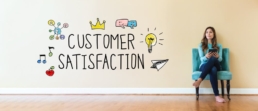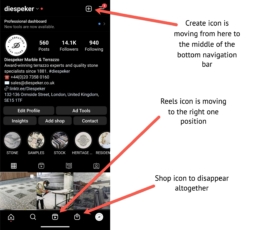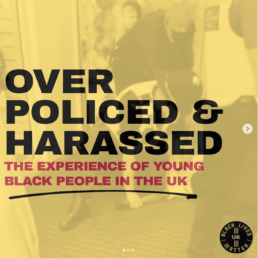Keep The Customer Satisfied
Wouldn’t you really rather know what your customers think of you?
Running a regular customer satisfaction programme is an essential strategy that businesses use to retain and grow their customer base. It’s a process of measuring satisfaction levels by collecting feedback from clients and using those insights to improve your business edge.
Some years ago, the agency I worked for sent me to Havard to learn about customer satisfaction processes designed to improve performance in the service industry. On my return, I implemented what I had learned. As a result, my agency subsequently ran a hugely successful customer satisfaction programme for many years. This survey (conducted twice a year) became a mainstay of our customer service programme.
A customer satisfaction programme enables you to better understand your client’s true feelings about your services. By collecting this feedback, you can identify their pain points and areas of dissatisfaction. You then use this information to adjust your services accordingly. This definitely helps to improve the overall customer experience, leading to increased customer retention, loyalty and advocacy.
But the key point is to gather customer feedback in a way that makes clients feel they can give an honest opinion without upsetting anyone. Consequently, the survey results must be highly confidential and your clients need to be made acutely aware of this. Ideally, a third party should be engaged to run the survey for you. This way, clients felt they are able to be more honest about their levels of satisfaction without directly putting anyone’s noses out of joint. Terra Ferma Media operates exactly this type of customer satisfaction survey for clients, using a slick, online survey tool.
By showing that you care about your clients’ opinions and experiences, you demonstrate that you value them as customers. Again, this leads to increased customer loyalty and advocacy, as well as positive word-of-mouth referrals. Stronger relationships with customers can even provide an opportunity to upsell or cross-sell additional products or services, further driving business growth.
By collecting feedback and using it to improve your offerings, you often differentiate yourself from competitors who may not be listening to their customers. This can help you gain a competitive edge in the marketplace, leading to increased market share and profitability.
But most importantly, a customer satisfaction programme can help you identify and address potential issues before they become major problems. By collecting feedback on a regular basis, you can detect patterns and trends that may indicate underlying issues. Addressing these issues early can help prevent customer churn and negative word-of-mouth, protecting your brand reputation and revenue.
So there we have it; running a customer satisfaction programme among clients is an essential strategy for improving and maintaining your business edge. It’s been a while but Terra Ferma Media is practising what we preach. Our next customer satisfaction survey goes out in early May.
If you would like us to run something similar for your business, just get in touch and we can show you how it’s done.
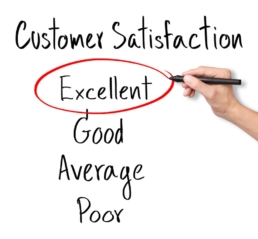
The Changing Landscape of Twitter: Why it's Becoming Harder for Businesses to Succeed
Here at Terra Ferma Media, we have seen first hand how Twitter has become seemingly less useful for smaller businesses.
One of the biggest reasons for this is the sheer volume of content on the platform, which makes it increasingly difficult to reach your target audience. With millions of tweets being posted every hour, businesses must work harder than ever to stand out and get their message heard. This is especially challenging for smaller businesses with limited budgets, as they may not have the resources to compete with larger, more established brands.
Twitter used to be a staple in the social media strategy for businesses of all sizes, but its effectiveness has been declining in recent years. While there are many factors that have contributed to this decline, one of the most recent is the influence of new owner Elon Musk, who has disrupted Twitter with his unconventional behaviour and unpredictable tweets. With his celebrity status, Musk’s tweets always garner more attention and engagement than those of regular users. However, his unpredictability and tendency to make controversial statements can create a volatile environment for businesses on the platform.
In recent developments, Twitter’s algorithm has evolved to prioritise engagement and relevance, which means that businesses must work even harder to get their tweets in front of their audience. This can be a challenge for new businesses that are trying to build their brand on the platform, as engagement is naturally lower from the start.
Another complication is the rise of advertising on Twitter. While this can be a powerful tool for businesses looking to promote their products or services, it can prove expensive and isn’t always an option for smaller businesses with limited budgets. It is more challenging than ever for businesses to get noticed without spending money on advertising, although that is increasingly the case with all mainstream social media channels. However, other social media platforms such as Instagram, Facebook, and LinkedIn tend to be more effective for businesses to grow and connect with their target audience. Instagram, for instance, has become the go-to platform for businesses that want to showcase their products or services through visual content. Similarly, Facebook’s (Meta’s) advertising tools have made it easier for businesses to reach their target audience based on their interests and demographics. LinkedIn has also become a powerful tool for businesses looking to connect with other professionals in their industry and establish themselves as thought leaders.
And what about the behaviour of some users on Twitter? Trolls and generally abusive accounts are creating a hostile environment for businesses – perhaps more so now that Musk has apparently cut back drastically on moderators. Negative comments and harassment can discourage businesses from engaging with their followers and promoting their brand on the platform, and can sometimes deter new customers.
In conclusion, Twitter has become a more challenging environment for businesses to operate in. While Elon Musk’s takeover has contributed to this, there are many other factors at play, including the volume of content, the changing algorithm, the rise of advertising, negative user behaviour, and the emergence of other social media platforms that are more effective for businesses. To succeed in today’s social media landscape, businesses must be strategic and thoughtful in their approach, focusing on creating valuable content and building authentic relationships with their followers on the platforms that best suit their needs.
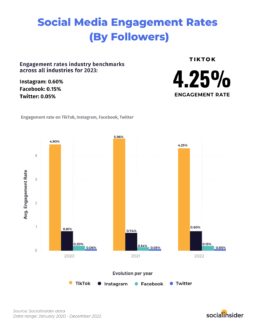
How much of a threat is AI to digital marketing agencies?*
Artificial intelligence (AI) could potentially pose a significant threat to digital marketing agencies, as it has the ability to automate many tasks that are currently done by mere mortals.
Some of the ways that AI could impact digital marketing agencies include:
- Automation of content creation: AI-powered tools like ChatGPT can generate written content quickly and with a high degree of coherence, which could make it harder for agencies to justify charging clients for writing services.
- Increased competition: As the cost of using AI-powered tools decreases, more companies may start to use them, which could lead to increased competition for digital marketing agencies.
- Decrease in job opportunities: AI may automate certain tasks that are currently done by human workers, which could lead to a decrease in job opportunities in the digital marketing industry.
- Improved targeting and personalization: AI-powered tools can analyze large amounts of data quickly, which can help companies to target their advertising more effectively and personalize their marketing messages.
- Improved ROI: With the help of AI, companies can make data-driven decisions, optimise their campaigns and get a better return on investment.
However…
It’s worth noting that these potential challenges should be seen as opportunities for digital marketing agencies to adapt and create new services by using new technology.
Some of the most significant opportunities include:
- Improved targeting and personalization: AI-powered tools can analyse large amounts of data quickly, which can help companies to target their advertising more effectively and personalise their marketing messages. This can lead to higher conversion rates and better customer engagement.
- Automation of repetitive tasks: AI can automate repetitive tasks such as data entry, campaign optimisation, and lead scoring, which can help agencies increase efficiency and reduce labour costs.
- Improved ROI: With the help of AI, companies can make data-driven decisions, optimise their campaigns and get a better return on investment.
- Predictive modelling: AI can help predict consumer behaviour, allowing companies to anticipate trends and create more effective marketing strategies.
- Chatbot and voice assistants: AI-powered chatbots and voice assistants can be used to provide 24/7 customer service and automate the sales process, improving customer experience.
- Content Generation: AI-powered tools can help to generate unique and high-quality content in a fraction of the time, which can be used for social media posts, email campaigns, blog posts and more.
With the right skills and approach, agencies can leverage AI to improve their services, increase efficiency, and offer new value to their clients.
*Disclaimer: The above article was entirely written by AI
Here at Terra Ferma Media, we’re not overly concerned about being replaced just yet. As you can see from the content above, this blog post comes across as devoid of personality and fairly mundane, even repetitive. Plus, currently, the most popular AI chatbot service has only gathered data up until the end of 2021. So – asking it to write an article about Rishi Sunak’s role as Prime Minister will draw a huge blank.
Furthermore, apps are being developed (as always) to counterbalance the onslaught of AI chatbots by easily identifying when content has been created by artificial intelligence. There’s even talk that Google Search may soon count identified chatbot content as spam, thus negatively impacting offending website rankings.
So tread carefully when deciding whether to use AI to instantly create your next copy project. There’s still some fight in us humans yet.
Oh, and what’s more, the real world is fighting back: AI image creator faces legal challenges from Getty

Instagram update sees shopping cart exit left
An announcement this week let the world know that Instagram will soon be updating its user navigation to ‘simplify’ things for everyone.
The biggest change sees the shopping bag Shop shortcut icon disappear from the app’s home screen navigation altogether. The news has generally met with approval among users who have felt that the commerce side of the app has, over the past few years, been forced front and centre at the expense of its more creative shortcuts. The move will see the Create button move from the top right navigation to, once again, be the most central icon on the main navigation bar with the Reels icon making way by moving one step to the right. The Shop icon will no longer be seen here at all.
Does this signal a change in direction for Instagram?
Don’t panic (!) – buying and selling on Instagram is here to stay and will continue to be easily accessible via the Discover shortcut (the magnifying glass one) as well as direct from Posts, Stories and Reels. But placing the Create shortcut front and centre once again could be seen as an attempt to prioritise creativity over commerce for the average IG user experience. And we like that.
What’s also interesting is that the ever-so-slight re-positioning of the Reels shortcut may signal acknowledgement that the IG powers that be have taken on board the ‘Make Instagram Instagram Again’ backlash from users who are unhappy that the app seemed to have been copying TikTok more and more since 2021.
The new Instagram changes start to roll out this February.
See how Head of Instagram Adam Mosseri announced the changes >
The rise in infographics on Instagram
If you are familiar with the social media app Instagram, you will know that its main purpose has been, traditionally, to share selfies and snapshots of one’s lifestyle. But there has been a significant rise in the use of educational infographics flooding everyone’s news feed, particularly in response to the Black Lives Matter movement.
Let’s take a look at how this has changed the way we use Instagram and how it promoting societal change for the younger generation.
What is an infographic?
An infographic is defined as ‘graphic visual representations of information, data, or knowledge intended to present information quickly and clearly.’
Instagram offer an image carousel with a maximum of 10 slides, which you can fill with whatever you like.
Users can take advantage of this feature, posting tailor-made graphics, with bold text, to explain elements of bite-sized concepts. They have proved to be a successful tool for education and spreading awareness, considering most young people consume most of their news on social media rather than on traditional news outlets.
The catalyst: Black Lives Matter
The trend of the Instagram infographic really came to the forefront following the tragic murder of George Floyd at the hands of a police officer in the United States. Our newsfeeds filled with selfies quickly turned into mini slideshows packed with cries for justice and equality, to define relevant words and phrases, and resources on how to support the Black Lives Matter movement. This trend was picked up by not only the everyday users but also celebrities and influencers who had vast followings on the platform.
Since then, the infographic had been adopted by other causes and is used frequently all over Instagram as a way to circulate information and educate on specific subjects or topics. They seem to spike when explaining especially complicated/heated political or social topics, such as for sharing the experiences held by women of sexual harassment in the light of the Sarah Everard case, or the Israeli-Palestinian conflict.
Here are some examples of how infographics are being used as an activism tool on Instagram at present:
@SophJButler posts a weekly ‘Sunday School’ graphic educating readers on specific issues regarding disability.
@everydayracism_ Graphics to educate on the subject of racism and how it can be challenged.
@theslowfactory Frequently upload carousel posts on a variety of topics using tailor-made graphics and citing sources along the bottom
How the infographic can be used for your business
The infographic is a brilliant way to condense a fair amount of information into a singular social post, which can be beneficial to a business selling any kind of product or service.
For example, Brigstock Skin & Laser who post infographics to their Instagram account to promote their monthly offers or to provide information surrounding their expertise.
Infographics can be utilised as a tool to answer frequently asked questions at a glance. This lessens the likelihood of a user dropping off because it has proved to hard to get the answers they needed.
Each slide of the infographic can be posted as an individual story for more exposure and saved to a highlight reel for future users to find.
The infographic tool allows a brand to share snapshots of what they are offering, without wordy, lengthy and frankly overcomplicated posts. Providing a call to action in the final slide or in the caption will allow users to find further information on your website, thus promoting traffic and hopefully leading to greater conversions.
How to get started with infographics
- The free tool, Canva, is going to be your best friend. It is a library of pre-made, fully customisable, social media content – including premade carousals and infographics! The great this is, you don’t need any prior experience with graphic design to get the most out of Canva.
- Customise your posts to reflect your branding and stick to your own colours and fonts. If Canva does not have your font in-built, you can upload it manually. Likewise, you can upload your own icons, images and logos.
- Keep the information concise, with a clear message, keeping to your brand’s tone of voice.
- Do not overpack each slide with text. It is best to make use of the 10 slide maximum to spread out the wording. Whilst you can download ready-to-go infographics with the text included, it is best to edit them so that people don’t recognise it from elsewhere and so it reflects your company’s mission.
- Put a small watermark on each of the slide, so that others cannot repost your content without crediting your business. This could be with a logo or with your Instagram handle.
Whether this is your introduction to infographics or you wanted to find new ways to make your infographics more effective, one thing is for sure, they have made a huge impact in all corners of the digital world and every marketing and social media professional should be embracing them – as they are clearly here to stay.


